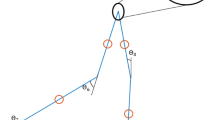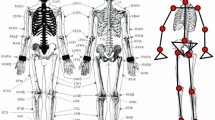Abstract
There is a growing interest in predicting the gait motion of real subjects under virtual conditions, e.g., to anticipate the result of surgery or to help in the design of prosthetic/orthotic devices. To this end, the motion parameters can be considered as the design parameters of an optimization problem. In this context, determination of the joint efforts for a given motion is a required step for the subsequent evaluation of cost function and constraints. In the double-support phase of gait, the ground reaction forces include twelve unknowns, rendering the inverse dynamics problem indeterminate if no force plate data are available. In this paper, several methods for solving the inverse dynamics problem of the human gait during the double-support phase, using force plates or not, are presented and compared.









Similar content being viewed by others
References
Ackermann, M., van den Bogert, A.J.: Optimality principles for model-based prediction of human gait. J. Biomech. 43(6), 1055–1060 (2010)
Ackermann, M., Schiehlen, W.: Dynamic analysis of human gait disorder and metabolical cost estimation. Arch. Appl. Mech. 75(10–12), 569–594 (2006)
Alonso, F., Cuadrado, J., Lugrís, U., Pintado, P.: A compact smoothing-differentiation and projection approach for the kinematic data consistency of biomechanical systems. Multibody Syst. Dyn. 24(1), 67–80 (2010)
Ambrósio, J.A.C., Kecskeméthy, A.: Multibody dynamics: computational methods and applications. In: Multibody Dynamics of Biomechanical Models for Human Motion via Optimization, pp. 245–272. Springer, Dordrecht (2007)
Anderson, F.C., Pandy, M.G.: Dynamic optimization of human walking. J. Biomech. Eng. 123(5), 381–390 (2001)
van den Bogert, A.J., Su, A.: A weighted least squares method for inverse dynamic analysis. Comput. Methods Biomech. Biomed. Eng. 11(1), 3–9 (2008)
Dopico, D., Luaces, A., González, M., Cuadrado, J.: Dealing with multiple contacts in a human-in-the-loop application. Multibody Syst. Dyn. 25(2), 167–183 (2011)
Flores, P., Machado, M., Silva, M., Martins, J.: On the continuous contact force models for soft materials in multibody dynamics. Multibody Syst. Dyn. 25(3), 357–375 (2011)
Gilchrist, L.A., Winter, D.A.: A two-part, viscoelastic foot model for use in gait simulations. J. Biomech. 29(6), 795–798 (1996)
Golyandina, N., Nekrutkin, V., Zhigljavsky, A.: Analysis of Time Series Structure: SSA and Related Techniques. Chapman & Hall/CRC, London, Boca Raton (2001)
Hansen, N.: The CMA evolution strategy: a comparing review. Stud. Fuzziness Soft Comput. 192, 75–102 (2006)
García de Jalón, J., Bayo, E.: Kinematic and Dynamic Simulation of Multibody Systems: The Real-Time Challenge. Springer, Berlin (1994)
Kecskeméthy, A.: A novel cylinder-plane foot contact model for human gait motion reproduction. In: Multibody Dynamics 2011, ECCOMAS Thematic Conference, Brussels, Belgium (2011)
Kuo, A.: A least-squares estimation approach to improving the precision of inverse dynamics computations. J. Biomech. Eng. 120(1), 148–159 (1998)
Lankarani, H.M., Nikravesh, P.E.: A contact force model with hysteresis dam** for impact analysis of multibody systems. J. Mech. Des. 112(3), 369–376 (1990)
Lu, T.W., O’Connor, J.J.: Bone position estimation from skin marker co-ordinates using global optimisation with joint constraints. J. Biomech. 32(2), 129–134 (1999)
Millard, M., McPhee, J., Kubica, E.: Multibody dynamics: computational methods and applications. In: Multi-Step Forward Dynamic Gait Simulation, pp. 25–43. Springer, Berlin (2008)
Murai, A., Yamane, K., Nakamura, Y.: Modeling and identification of human neuromusculoskeletal network based on biomechanical property of muscle. In: 30th Annual International Conference of the IEEE Engineering in Medicine and Biology Society, EMBS’08, Vancouver, Canada, pp. 3706–3709 (2008)
O’Connor, C.M., Thorpe, S.K., O’Malley, M.J., Vaughan, C.L.: Automatic detection of gait events using kinematic data. Gait Posture 25(3), 469–474 (2007)
Reinbolt, J.A., Schutte, J.F., Fregly, B.J., Koh, B.I., Haftka, R.T., George, A.D., Mitchell, K.H.: Determination of patient-specific multi-joint kinematic models through two-level optimization. J. Biomech. 38(3), 621–626 (2005)
Ren, L., Jones, R.K., Howard, D.: Predictive modelling of human walking over a complete gait cycle. J. Biomech. 40(7), 1567–1574 (2007)
Ren, L., Jones, R.K., Howard, D.: Whole body inverse dynamics over a complete gait cycle based only on measured kinematics. J. Biomech. 41(12), 2750–2759 (2008)
Rodrigo, S., Ambrósio, J., Da Silva, M., Penisi, O.: Analysis of human gait based on multibody formulations and optimization tools. Mech. Based Des. Struct. Mach. 36(4), 446–477 (2008)
Silva, M., Ambrósio, J.: Kinematic data consistency in the inverse dynamic analysis of biomechanical systems. Multibody Syst. Dyn. 8(2), 219–239 (2002)
Umberger, B.R., Gerritsen, K.G., Martin, P.E.: A model of human muscle energy expenditure. Comput. Methods Biomech. Biomed. Eng. 6(2), 99–111 (2003)
Vaughan, C.L., Davis, B.L., O’Connor, J.C.: Dynamics of Human Gait, 2nd edn. Kiboho, Cape Town (1999)
**ang, Y., Chung, H.J., Kim, J.H., Bhatt, R., Rahmatalla, S., Yang, J., Marler, T., Arora, J., Abdel-Malek, K.: Predictive dynamics: an optimization-based novel approach for human motion simulation. Struct. Multidiscip. Optim. 41(3), 465–479 (2010)
Acknowledgements
The support of this work by the Spanish Ministry of Science and Innovation under the project DPI2009–13438–C03, cofinanced by the European Union through EFRD funds, is acknowledged. The help from Álvaro Noriega, from University of Oviedo, Spain, in the selection of the optimization algorithm is also acknowledged.
Author information
Authors and Affiliations
Corresponding author
Rights and permissions
About this article
Cite this article
Lugrís, U., Carlín, J., Pàmies-Vilà, R. et al. Solution methods for the double-support indeterminacy in human gait. Multibody Syst Dyn 30, 247–263 (2013). https://doi.org/10.1007/s11044-013-9363-x
Received:
Accepted:
Published:
Issue Date:
DOI: https://doi.org/10.1007/s11044-013-9363-x




